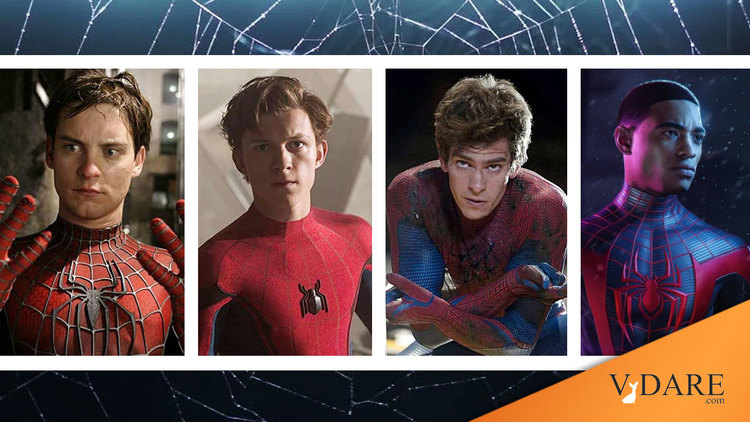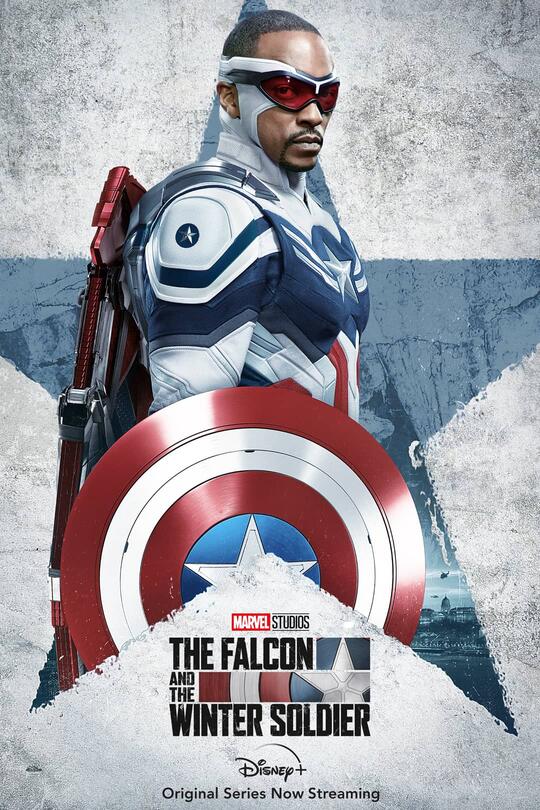


By Paul Kersey
01/10/2022
As expected with supernova films of the Marvel Cinematic Universe, Spider-Man: No Way Home had one of the biggest openings ever [‘Spider-Man: No Way Home’ Defeats ‘Infinity War’ & Notches 2nd Highest Domestic Opening At The Box Office With $260M, by Anthony D'Alessandro, Deadline, December 20, 2021]. And it’s the first film released since the Flu Manchu pandemic began in March 2020 that has pulled in $1 billion worldwide [Spider-Man: No Way Home first pandemic film to hit $1 billion, by Roger Cheng, CNet.com, December 27, 2021]. But one fact might still wreck the series for good: the next Spider-Man could well be a “person of color,” another step in the MCU’s Great Replacement.
After nine Spider-Man movies since 2002, the trajectory of the series is now clear. It’s more about reinforcing the Woke Zeitgeist instead of making entertaining movies — as Sam Raimi set out to do with his initial trilogy starring Tobey Maguire as the eponymous "webslinger" (as he’s called) — a white teenager from Queens whose real identity is Peter Parker, a photography nut and stringer for the Daily Bugle. Now the character is an avatar of what has been called the Global American Empire.
Consider the history.
Three white men have played completely different versions of Spider-Man. In the original film Spider-Man [2002] on a field trip to Columbia University’s genetics laboratory a purple radioactive spider chomped down on Parker’s hand. Superpowers ensued.
Eight movies are live-action: three with Tobey Maguire; two with Andrew Garfield in Sony’s 2012 reboot, The Amazing Spider-Man and its sequel; and three with Tom Holland, who was introduced in 2016’s Captain America: Civil War. Holland also appeared in 2018’s Avengers: Infinity War and 2019’s Avengers: Endgame. The latter killed off the franchise’s two greatest heroes: the very white Captain America, and the vaguely-foreign-looking-but-still-white Iron Man.
The ninth film, released in 2018, is a cartoon: Spider-Man: Into the Spider-Verse. Though unrelated to the live-action movies, it introduced the “multiverse” and plotline of No Way Home.
As for the latest installment’s plot, after Parker’s identity is revealed, Holland’s Spidey asks the wizard of the MCU, Dr. Strange, to cast a spell to make everyone forget he is the masked hero who swings between the skyscrapers. Instead, the spell imports the villains from the Maguire and Garfield films, and the three white Spider-Men men unite to save not just one world, but the newly introduced multiverse.
That’s where the Great Replacement comes in. As I’ve written before, Disney is remaking every MCU superhero, man or woman, to meet the demands of the Woke. Captain America, for instance, is no longer a blond-haired, blue-eyed super soldier. He’s a black dude.

In 2019’s Avengers: Endgame, the attempt to kill off MCU’s white men was seemingly complete. Robert Downey Jr.’s Iron Man died saving the world, and Chris Evans’ Captain America surrendered the shield to his black best buddy and went back in time to relive his life as a normal guy.
By now, your Spidey-sense should be tingling. The original film made 19 years ago featured a shockingly white New York City, and virtually every character was white. The films were wildly popular.
Then came Garfield’s Spider-Man, which flopped. Forgotten is that just prior to his second turn, the effeminate Garfield pushed for Parker not only to be homosexual, but also to hook up with a black guy:
“I was kind of joking, but kind of not joking about MJ,” he tells EW. “And I was like, ‘What if MJ is a dude?’ Why can’t we discover that Peter is exploring his sexuality? It’s hardly even groundbreaking! … So why can’t he be gay? Why can’t he be into boys?”
Garfield even has an actor in mind: “I’ve been obsessed with Michael B. Jordan since The Wire. He’s so charismatic and talented. It’d be even better — we’d have interracial bisexuality!”
[Andrew Garfield on Spider-Man’s sexuality: ‘Why can’t he be gay?,’ by Sara Vilkomerson, Entertainment Weekly, July 10, 2013]
Garfield was “obsessed” with a black man? That might explain why he seems to have more than a passing interest in turning Spider-Man into a homosexual. “As far as I know, I am not a gay man,” Garfield said a few years later when he starred in a stage version of HBO’s AIDS propaganda miniseries, Angels Over America:
Maybe I’ll have an awakening later in my life, which I’m sure will be wonderful and I’ll get to explore that part of the garden. … I am a gay man right now just without the physical act — that’s all.
[Andrew Garfield raises eyebrows, ire with ‘gay without the physical act’ comment, by Jayme Deerwester, USA Today, July 6, 2017]
Hmmm. Let’s move on. When the Garfield sequel bombed, producers scrapped plans for a third. A few years later, we learned via Wikileaks that contracts required that Parker must be white. He and Spider-Man had to be heterosexual.
Peter Parker and his alter ego Spider-Man must be heterosexual and Parker must be Caucasian, according to a legal licensing agreement between Sony Pictures Entertainment and Marvel Entertainment.
The information was disclosed in a massive document release by the whistleblower website WikiLeaks, which released this week 276,394 private files, emails and financial data onto its servers.
Sony Pictures and Marvel reps declined to comment on the licensing agreement, first reported by the Gawker website.
The contract went into effect in September 2011. It lists “mandatory” character traits for both Peter Parker and Spider-Man — and the agreement includes the caveat that Spider-Man is “not a homosexual (unless Marvel has portrayed that alter ego as a homosexual).”
[Spider-Man Needs to Be White and Straight, Say Leaked Sony Emails, Dave McNary, Variety, June 19, 2015]
Even Stan Lee, the cocreator of Spider-Man who died in 2018, agreed that Parker must always be a white heterosexual.
“I wouldn’t mind, if Peter Parker had originally been black, a Latino, an Indian or anything else, that he stay that way,” he said. “But we originally made him white. I don’t see any reason to change that.”
Lee is also in agreement with the requirement that Parker’s sexuality should remain as originally written, but is open to the idea of other homosexual comic book characters.
“I think the world has a place for gay superheroes, certainly,” he said. “But again, I don’t see any reason to change the sexual proclivities of a character once they’ve already been established. I have no problem with creating new, homosexual superheroes.”
Lee was also keen to point out that his remarks had nothing to do with bigotry, but rather with staying true to his work.
“It has nothing to do with being anti-gay, or anti-black, or anti-Latino, or anything like that,” he said. “Latino characters should stay Latino. The Black Panther should certainly not be Swiss. I just see no reason to change that which has already been established when it’s so easy to add new characters. I say create new characters the way you want to. Hell, I’ll do it myself.”
His comments follow news that Miles Morales, a mixed-race iteration of Spider-Man, will be replacing Peter Parker in the comics.
[Stan Lee: Spider-Man should stay white and straight, by Benjamin Lee, The Guardian, June 23, 2015].
Parker stayed a white, heterosexual male in Holland’s iterations, but almost every supporting character was a non-white, including his love interest [Diversity isn’t a plot point in ‘Spider-Man: Homecoming.’ It’s just normal for millennial New Yorkers like Peter Parker, by Jen Yamato, Los Angeles Times, July 10, 2017]. Indeed, the new MJ, Parker’s main squeeze, is a bonus for Wokesters. Opposite Maguire’s Spider-Man, MJ began as Kirsten Dunst’s stunning, blue-eyed, redhead with a typically American name, Mary Jane Watson.

Now, opposite Holland in No Way Home, MJ is Michelle Jones-Watson, played by the not-very-pretty, half-black Zendaya.

Apropos of Lee’s concern, that’s where Miles Morales comes in with Spider-Man: Into the Spider-Verse. In that one, Spidey is half-black/half-Latino:
In the pages of Ultimate Spider-Man (2000) Brian Michael Bendis and Mark Bagley re-envisioned Spider-Man for the 21st century, capitalizing on the buzz surrounding the production of Sam Raimi’s Spider-Man (2002). For a decade Bendis told Peter Parker’s story, reinventing friends and enemies, and asking how a teenage superhero would function in the world of cellphones, Internet and instant celebrity. But even as he was telling this story, the world was rapidly changing. America was experiencing a shift in culture. The immigration of Mexicans and Africans to America was receiving increased attention, schools were becoming increasingly diverse, biracial relationships were increasingly common and our language was changing not only in the increase of bilingual persons, but in how our slang was infused with Spanish and Ebonics. In 2008, America elected President Barack Obama, whose biracial background and message of hope also served as a bridge. Two years later, Sony announced it would be rebooting the Spider-Man film series with The Amazing Spider-Man (2012) and actor-rapper Donald Glover expressed interest in playing Peter Parker. The idea caught on and gained momentum, sparking conversations that begged the question, “Why does Spider-Man have to be white?”
[‘Into the Spider-Verse’ and the Importance of a Biracial Spider-Man, by Richard Newby, Hollywood Reporter, December 12, 2018]
And so the MCU’s Great Replacers replaced the white Spider-Man. This exchange in No Way Home between Max Dillon, alter-ego of black villain Electro (Jamie Fox), and Garfield’s Spider-Man is enlightening:
Max: You got a nice face, you just a kid.
Peter: Eh.
Max: You from Queens, you got that suit, you help a lot of poor people. I just thought you was going to be black.
Peter: Oh man, I’m sorry, sir.
Max: Got to be a black Spider-Man somewhere out there.
[How Spider-Man: No Way Home Sets Up Miles Morales' Live-Action Debut, by Klein Felt, TheDirect.com, December 20, 2021]

So Parker apologizes for being a white guy to a black villain (who was, by the way, white in the comic books).
Upshot of it all? Spider-Man: No Way Home, in which three white Spider-Men save the world and the multiverse, teases Miles Morales’ brown webslinger.
First Captain America and Iron Man. Now Spider-Man. Soon, The Great Replacement of white heroes in the MCU will be complete.
We already knew that comic books and spin-off films aren’t safe. Little did we know, however, how determined their creators are to wipe out whites entirely.
The Powers That Be at Sony and Disney might not have fully considered one significant fact. The MCU’s white heroes — who mirror the Historic American Nation’s overwhelmingly white majority — remain the most popular in the unbelievably lucrative MCU.
“With great power, comes great responsibility,” Parker’s beloved Uncle Ben told him in the first film.
True enough. We can only hope that the Woke execs, producers and directors at Sony-Disney find out what happens when they exercise their power irresponsibly.
At $9.16 a ticket, on average, the MCU’s mostly-white fan base dug deep to shower No Way Home with a billion-dollar box-office bonanza.
Maybe they’ll think twice about dishing out another billion bucks when the browning of Spider-Man is complete.

Paul Kersey is the author of the blog SBPDL, and has published the books SBPDL Year One, Hollywood in Blackface and Escape From Detroit, Opiate of America: College Football in Black and White and Second City Confidential: The Black Experience in Chicagoland. His latest book is The Tragic City: Birmingham 1963-2013.